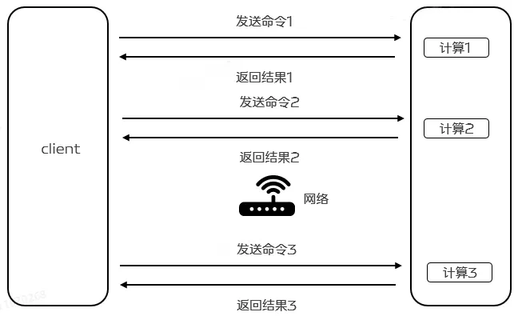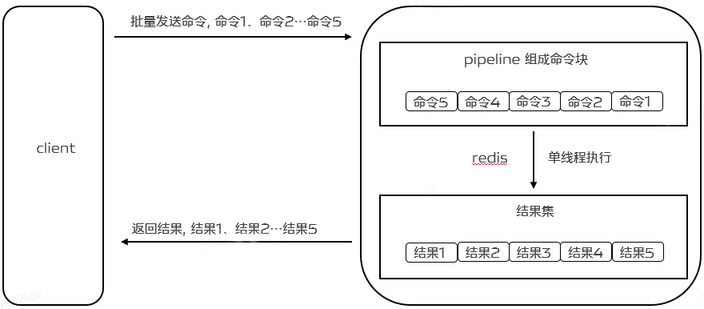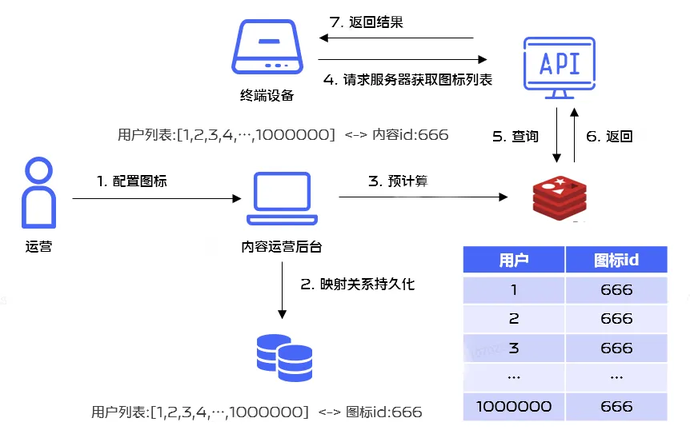作者:vivo 互联网服务器团队-Wang Fei
Redis 是一种基于客户端-服务端模型以及请求/响应的 TCP 服务。在遇到批处理命令执行时,Redis 提供了 Pipelining(管道)来提升批处理性能。本文结合实践分析了 Spring Boot 框架下 Redis 的 Lettuce 客户端和 Redisson 客户端对 Pipeline 特性的支持原理,并针对实践过程中遇到的问题进行了分析,可以帮助开发者了解不同客户端对 Pipeline 支持原理及避免实际使用中出现问题。
一、前言
Redis 已经提供了像 mget 、mset 这种批量的命令,但是某些操作根本就不支持或没有批量的操作,从而与 Redis 高性能背道而驰。为此, Redis 基于管道机制,提供 Redis Pipeline 新特性。Redis Pipeline 是一种通过一次性发送多条命令并在执行完后一次性将结果返回,从而减少客户端与 redis 的通信次数来实现降低往返延时时间提升操作性能的技术。目前,Redis Pipeline 是被很多个版本的 Redis 客户端所支持的。
二、Pipeline 底层原理分析
2.1 Redis 单个命令执行基本步骤
Redis 是一种基于客户端-服务端模型以及请求/响应的 TCP 服务。一次 Redis 客户端发起的请求,经过服务端的响应后,大致会经历如下的步骤:
客户端发起一个(查询/插入)请求,并监听 socket 返回,通常情况都是阻塞模式等待 Redis 服务器的响应。
服务端处理命令,并且返回处理结果给客户端。
客户端接收到服务的返回结果,程序从阻塞代码处返回。
2.2 RTT 时间
Redis 客户端和服务端之间通过网络连接进行数据传输,数据包从客户端到达服务器,并从服务器返回数据回复客户端的时间被称之为 RTT(Round Trip Time - 往返时间)。我们可以很容易就意识到,Redis 在连续请求服务端时,如果 RTT 时间为 250ms, 即使 Redis 每秒能处理 100k 请求,但也会因为网络传输花费大量时间,导致每秒最多也只能处理 4 个请求,导致整体性能的下降。
2.3 Redis Pipeline
为了提升效率,这时候 Pipeline 出现了。Pipelining 不仅仅能够降低 RRT,实际上它极大的提升了单次执行的操作数。这是因为如果不使用 Pipelining,那么每次执行单个命令,从访问数据的结构和服务端产生应答的角度,它的成本是很低的。但是从执行网络 IO 的角度,它的成本其实是很高的。其中涉及到 read()和 write()的系统调用,这意味着需要从用户态切换到内核态,而这个上下文的切换成本是巨大的。
当使用 Pipeline 时,它允许多个命令的读通过一次 read()操作,多个命令的应答使用一次 write()操作,它允许客户端可以一次发送多条命令,而不等待上一条命令执行的结果。不仅减少了 RTT,同时也减少了 IO 调用次数(IO 调用涉及到用户态到内核态之间的切换),最终提升程序的执行效率与性能。如下图:
要支持 Pipeline,其实既要服务端的支持,也要客户端支持。对于服务端来说,所需要的是能够处理一个客户端通过同一个 TCP 连接发来的多个命令,可以理解为,这里将多个命令切分,和处理单个命令一样,Redis 就是这样处理的。而客户端,则是要将多个命令缓存起来,缓冲区满了就发送,然后再写缓冲,最后才处理 Redis 的应答。
三、Pipeline 基本使用及性能比较
下面我们以给 10w 个 set 结构分别插入一个整数值为例,分别使用 jedis 单个命令插入、jedis 使用 Pipeline 模式进行插入和 redisson 使用 Pipeline 模式进行插入以及测试其耗时。
@Slf4jpublic class RedisPipelineTestDemo { public static void main(String[] args) { //连接redis Jedis jedis = new Jedis("10.101.17.180", 6379); //jedis逐一给每个set新增一个value String zSetKey = "Pipeline-test-set"; int size = 100000; long begin = System.currentTimeMillis(); for (int i = 0; i < size; i++) { jedis.sadd(zSetKey + i, "aaa"); } log.info("Jedis逐一给每个set新增一个value耗时:{}ms", (System.currentTimeMillis() - begin)); //Jedis使用Pipeline模式 Pipeline Pipeline = jedis.Pipelined(); begin = System.currentTimeMillis(); for (int i = 0; i < size; i++) { Pipeline.sadd(zSetKey + i, "bbb"); } Pipeline.sync(); log.info("Jedis Pipeline模式耗时:{}ms", (System.currentTimeMillis() - begin)); //Redisson使用Pipeline模式 Config config = new Config(); config.useSingleServer().setAddress("redis://10.101.17.180:6379"); RedissonClient redisson = Redisson.create(config); RBatch redisBatch = redisson.createBatch(); begin = System.currentTimeMillis(); for (int i = 0; i < size; i++) { redisBatch.getSet(zSetKey + i).addAsync("ccc"); } redisBatch.execute(); log.info("Redisson Pipeline模式耗时:{}ms", (System.currentTimeMillis() - begin)); //关闭 Pipeline.close(); jedis.close(); redisson.shutdown(); }}
复制代码
测试结果如下:
Jedis 逐一给每个 set 新增一个 value 耗时:162655ms
Jedis Pipeline 模式耗时:504ms
Redisson Pipeline 模式耗时:1399ms
我们发现使用 Pipeline 模式对应的性能会明显好于单个命令执行的情况。
四、项目中实际应用
在实际使用过程中有这样一个场景,很多应用在节假日的时候需要更新应用图标样式,在运营进行后台配置的时候, 可以根据圈选的用户标签预先计算出单个用户需要下发的图标样式并存储在 Redis 里面,从而提升性能,这里就涉及 Redis 的批量操作问题,业务流程如下:
为了提升 Redis 操作性能,我们决定使用 Redis Pipelining 机制进行批量执行。
4.1 Redis 客户端对比
针对 Java 技术栈而言,目前 Redis 使用较多的客户端为 Jedis、Lettuce 和 Redisson。
目前项目主要是基于 SpringBoot 开发,针对 Redis,其默认的客户端为 Lettuce,所以我们基于 Lettuce 客户端进行分析。
4.2 Spring 环境下 Lettuce 客户端对 Pipeline 的实现
在 Spring 环境下,使用 Redis 的 Pipeline 也是很简单的。spring-data-redis 提供了 StringRedisTemplate 简化了对 Redis 的操作, 只需要调用 StringRedisTemplate 的 executePipelined 方法就可以了,但是在参数中提供了两种回调方式:SessionCallback 和 RedisCallback。
两种使用方式如下(这里以操作 set 结构为例):
public void testRedisCallback() { List<Integer> ids= Arrays.asList(1, 2, 3, 4, 5, 6, 7, 8, 9); Integer contentId = 1; redisTemplate.executePipelined(new InsertPipelineExecutionA(ids, contentId)); } @AllArgsConstructor private static class InsertPipelineExecutionA implements RedisCallback<Void> { private final List<Integer> ids; private final Integer contentId; @Override public Void doInRedis(RedisConnection connection) DataAccessException { RedisSetCommands redisSetCommands = connection.setCommands(); ids.forEach(id-> { String redisKey = "aaa:" + id; String value = String.valueOf(contentId); redisSetCommands.sAdd(redisKey.getBytes(), value.getBytes()); }); return null; } }
复制代码
public void testSessionCallback() { List<Integer> ids= Arrays.asList(1, 2, 3, 4, 5, 6, 7, 8, 9); Integer contentId = 1; redisTemplate.executePipelined(new InsertPipelineExecutionB(ids, contentId)); } @AllArgsConstructor private static class InsertPipelineExecutionB implements SessionCallback<Void> { private final List<Integer> ids; private final Integer contentId; @Override public <K, V> Void execute(RedisOperations<K, V> operations) throws DataAccessException { SetOperations<String, String> setOperations = (SetOperations<String, String>) operations.opsForSet(); ids.forEach(id-> { String redisKey = "aaa:" + id; String value = String.valueOf(contentId); setOperations.add(redisKey, value); }); return null; } }
复制代码
4.3 RedisCallBack 和 SessionCallback 之间的比较
1、RedisCallBack 和 SessionCallback 都可以实现回调,通过它们可以在同一条连接中一次执行多个 redis 命令。
2、RedisCallback 使用的是原生 RedisConnection,用起来比较麻烦,比如上面执行 set 的 add 操作,key 和 value 需要进行转换,可读性差,但原生 api 提供的功能比较齐全。
3、SessionCalback 提供了良好的封装,可以优先选择使用这种回调方式。
最终的代码实现如下:
public void executeB(List<Integer> userIds, Integer iconId) { redisTemplate.executePipelined(new InsertPipelineExecution(userIds, iconId));} @AllArgsConstructorprivate static class InsertPipelineExecution implements SessionCallback<Void> { private final List<Integer> userIds; private final Integer iconId; @Override public <K, V> Void execute(RedisOperations<K, V> operations) throws DataAccessException { SetOperations<String, String> setOperations = (SetOperations<String, String>) operations.opsForSet(); userIds.forEach(userId -> { String redisKey = "aaa:" + userId; String value = String.valueOf(iconId); setOperations.add(redisKey, value); }); return null; }}
复制代码
4.4 源码分析
那么为什么使用 Pipeline 方式会对性能有较大提升呢,我们现在从源码入手着重分析一下:
4.4.1 Pipeline 方式下获取连接相关原理分析:
@Override public List<Object> executePipelined(SessionCallback<?> session, @Nullable RedisSerializer<?> resultSerializer) { Assert.isTrue(initialized, "template not initialized; call afterPropertiesSet() before using it"); Assert.notNull(session, "Callback object must not be null"); //1. 获取对应的Redis连接工厂 RedisConnectionFactory factory = getRequiredConnectionFactory(); //2. 绑定连接过程 RedisConnectionUtils.bindConnection(factory, enableTransactionSupport); try { //3. 执行命令流程, 这里请求参数为RedisCallback, 里面有对应的回调操作 return execute((RedisCallback<List<Object>>) connection -> { //具体的回调逻辑 connection.openPipeline(); boolean PipelinedClosed = false; try { //执行命令 Object result = executeSession(session); if (result != null) { throw new InvalidDataAccessApiUsageException( "Callback cannot return a non-null value as it gets overwritten by the Pipeline"); } List<Object> closePipeline = connection.closePipeline(); PipelinedClosed = true; return deserializeMixedResults(closePipeline, resultSerializer, hashKeySerializer, hashValueSerializer); } finally { if (!PipelinedClosed) { connection.closePipeline(); } } }); } finally { RedisConnectionUtils.unbindConnection(factory); } }
复制代码
① 获取对应的 Redis 连接工厂,这里要使用 Pipeline 特性需要使用 LettuceConnectionFactory 方式,这里获取的连接工厂就是 LettuceConnectionFactory。
② 绑定连接过程,具体指的是将当前连接绑定到当前线程上面, 核心方法为:doGetConnection。
public static RedisConnection doGetConnection(RedisConnectionFactory factory, boolean allowCreate, boolean bind, boolean enableTransactionSupport) { Assert.notNull(factory, "No RedisConnectionFactory specified"); //核心类,有缓存作用,下次可以从这里获取已经存在的连接 RedisConnectionHolder connHolder = (RedisConnectionHolder) TransactionSynchronizationManager.getResource(factory); //如果connHolder不为null, 则获取已经存在的连接, 提升性能 if (connHolder != null) { if (enableTransactionSupport) { potentiallyRegisterTransactionSynchronisation(connHolder, factory); } return connHolder.getConnection(); } ...... //第一次获取连接,需要从Redis连接工厂获取连接 RedisConnection conn = factory.getConnection(); //bind = true 执行绑定 if (bind) { RedisConnection connectionToBind = conn; ...... connHolder = new RedisConnectionHolder(connectionToBind); //绑定核心代码: 将获取的连接和当前线程绑定起来 TransactionSynchronizationManager.bindResource(factory, connHolder); ...... return connHolder.getConnection(); } return conn; }
复制代码
里面有个核心类 RedisConnectionHolder,我们看一下 RedisConnectionHolder connHolder =
(RedisConnectionHolder) TransactionSynchronizationManager.getResource(factory);
@Nullable public static Object getResource(Object key) { Object actualKey = TransactionSynchronizationUtils.unwrapResourceIfNecessary(key); Object value = doGetResource(actualKey); if (value != null && logger.isTraceEnabled()) { logger.trace("Retrieved value [" + value + "] for key [" + actualKey + "] bound to thread [" + Thread.currentThread().getName() + "]"); } return value; }
复制代码
里面有一个核心方法 doGetResource(actualKey),大家很容易猜测这里涉及到一个 map 结构,如果我们看源码,也确实是这样一个结构。
@Nullable private static Object doGetResource(Object actualKey) { Map<Object, Object> map = resources.get(); if (map == null) { return null; } Object value = map.get(actualKey); // Transparently remove ResourceHolder that was marked as void... if (value instanceof ResourceHolder && ((ResourceHolder) value).isVoid()) { map.remove(actualKey); // Remove entire ThreadLocal if empty... if (map.isEmpty()) { resources.remove(); } value = null; } return value; }
复制代码
resources 是一个 ThreadLocal 类型,这里会涉及到根据 RedisConnectionFactory 获取到连接 connection 的逻辑,如果下一次是同一个 actualKey,那么就直接使用已经存在的连接,而不需要新建一个连接。第一次这里 map 为 null,就直接返回了,然后回到 doGetConnection 方法,由于这里 bind 为 true,我们会执行 TransactionSynchronizationManager.bindResource(factory, connHolder);,也就是将连接和当前线程绑定了起来。
public static void bindResource(Object key, Object value) throws IllegalStateException { Object actualKey = TransactionSynchronizationUtils.unwrapResourceIfNecessary(key); Assert.notNull(value, "Value must not be null"); Map<Object, Object> map = resources.get(); // set ThreadLocal Map if none found if (map == null) { map = new HashMap<>(); resources.set(map); } Object oldValue = map.put(actualKey, value); ...... }
复制代码
③ 我们回到 executePipelined,在获取到连接工厂,将连接和当前线程绑定起来以后,就开始需要正式去执行命令了, 这里会调用 execute 方法
@Override@Nullablepublic <T> T execute(RedisCallback<T> action) { return execute(action, isExposeConnection());}
复制代码
这里我们注意到 execute 方法的入参为 RedisCallback<T>action,RedisCallback 对应的 doInRedis 操作如下,这里在后面的调用过程中会涉及到回调。
connection.openPipeline();boolean PipelinedClosed = false;try { Object result = executeSession(session); if (result != null) { throw new InvalidDataAccessApiUsageException( "Callback cannot return a non-null value as it gets overwritten by the Pipeline"); } List<Object> closePipeline = connection.closePipeline(); PipelinedClosed = true; return deserializeMixedResults(closePipeline, resultSerializer, hashKeySerializer, hashValueSerializer);} finally { if (!PipelinedClosed) { connection.closePipeline(); }}
复制代码
我们再来看 execute(action, isExposeConnection())方法,这里最终会调用<T>execute(RedisCallback<T>action, boolean exposeConnection, boolean Pipeline)方法。
@Nullablepublic <T> T execute(RedisCallback<T> action, boolean exposeConnection, boolean Pipeline) { Assert.isTrue(initialized, "template not initialized; call afterPropertiesSet() before using it"); Assert.notNull(action, "Callback object must not be null"); //获取对应的连接工厂 RedisConnectionFactory factory = getRequiredConnectionFactory(); RedisConnection conn = null; try { if (enableTransactionSupport) { // only bind resources in case of potential transaction synchronization conn = RedisConnectionUtils.bindConnection(factory, enableTransactionSupport); } else { //获取对应的连接(enableTransactionSupport=false) conn = RedisConnectionUtils.getConnection(factory); } boolean existingConnection = TransactionSynchronizationManager.hasResource(factory); RedisConnection connToUse = preProcessConnection(conn, existingConnection); boolean PipelineStatus = connToUse.isPipelined(); if (Pipeline && !PipelineStatus) { connToUse.openPipeline(); } RedisConnection connToExpose = (exposeConnection ? connToUse : createRedisConnectionProxy(connToUse)); //核心方法,这里就开始执行回调操作 T result = action.doInRedis(connToExpose); // close Pipeline if (Pipeline && !PipelineStatus) { connToUse.closePipeline(); } // TODO: any other connection processing? return postProcessResult(result, connToUse, existingConnection); } finally { RedisConnectionUtils.releaseConnection(conn, factory, enableTransactionSupport); }}
复制代码
我们看到这里最开始也是获取对应的连接工厂,然后获取对应的连接(enableTransactionSupport=false),具体调用是 RedisConnectionUtils.getConnection(factory)方法,最终会调用 RedisConnection doGetConnection(RedisConnectionFactory factory, booleanallowCreate, boolean bind, boolean enableTransactionSupport),此时 bind 为 false
public static RedisConnection doGetConnection(RedisConnectionFactory factory, boolean allowCreate, boolean bind, boolean enableTransactionSupport) { Assert.notNull(factory, "No RedisConnectionFactory specified"); //直接获取与当前线程绑定的Redis连接 RedisConnectionHolder connHolder = (RedisConnectionHolder) TransactionSynchronizationManager.getResource(factory); if (connHolder != null) { if (enableTransactionSupport) { potentiallyRegisterTransactionSynchronisation(connHolder, factory); } return connHolder.getConnection(); } ...... return conn;}
复制代码
前面我们分析过一次,这里调用 RedisConnectionHolder connHolder = (RedisConnectionHolder)TransactionSynchronizationManager.getResource(factory);会获取到之前和当前线程绑定的 Redis,而不会新创建一个连接。
然后会去执行 T result = action.doInRedis(connToExpose),这里的 action 为 RedisCallback,执行 doInRedis 为:
//开启Pipeline功能connection.openPipeline();boolean PipelinedClosed = false;try { //执行Redis命令 Object result = executeSession(session); if (result != null) { throw new InvalidDataAccessApiUsageException( "Callback cannot return a non-null value as it gets overwritten by the Pipeline"); } List<Object> closePipeline = connection.closePipeline(); PipelinedClosed = true; return deserializeMixedResults(closePipeline, resultSerializer, hashKeySerializer, hashValueSerializer);} finally { if (!PipelinedClosed) { connection.closePipeline(); }}
复制代码
这里最开始会开启 Pipeline 功能,然后执行 Object result = executeSession(session);
private Object executeSession(SessionCallback<?> session) { return session.execute(this);}
复制代码
这里会调用我们自定义的 execute 方法
@AllArgsConstructorprivate static class InsertPipelineExecution implements SessionCallback<Void> { private final List<Integer> userIds; private final Integer iconId; @Override public <K, V> Void execute(RedisOperations<K, V> operations) throws DataAccessException { SetOperations<String, String> setOperations = (SetOperations<String, String>) operations.opsForSet(); userIds.forEach(userId -> { String redisKey = "aaa:" + userId; String value = String.valueOf(iconId); setOperations.add(redisKey, value); }); return null; }}
复制代码
进入到 foreach 循环,执行 DefaultSetOperations 的 add 方法。
@Overridepublic Long add(K key, V... values) { byte[] rawKey = rawKey(key); byte[][] rawValues = rawValues((Object[]) values); //这里的connection.sAdd是后续回调要执行的方法 return execute(connection -> connection.sAdd(rawKey, rawValues), true);}
复制代码
这里会继续执行 redisTemplate 的 execute 方法,里面最终会调用我们之前分析过的
<T>T execute(RedisCallback<T>action, boolean exposeConnection, boolean Pipeline)方法。
@Nullablepublic <T> T execute(RedisCallback<T> action, boolean exposeConnection, boolean Pipeline) { Assert.isTrue(initialized, "template not initialized; call afterPropertiesSet() before using it"); Assert.notNull(action, "Callback object must not be null"); RedisConnectionFactory factory = getRequiredConnectionFactory(); RedisConnection conn = null; try { ...... //再次执行回调方法,这里执行的Redis基本数据结构对应的操作命令 T result = action.doInRedis(connToExpose); ...... // TODO: any other connection processing? return postProcessResult(result, connToUse, existingConnection); } finally { RedisConnectionUtils.releaseConnection(conn, factory, enableTransactionSupport); }}
复制代码
这里会继续执行 T result = action.doInRedis(connToExpose);,这里其实执行的 doInRedis 方法为:
connection -> connection.sAdd(rawKey, rawValues)
复制代码
4.4.2 Pipeline 方式下执行命令的流程分析:
① 接着上面的流程分析,这里的 sAdd 方法实际调用的是 DefaultStringRedisConnection 的 sAdd 方法
@Overridepublic Long sAdd(byte[] key, byte[]... values) { return convertAndReturn(delegate.sAdd(key, values), identityConverter);}
复制代码
② 这里会进一步调用 DefaultedRedisConnection 的 sAdd 方法
@Override@Deprecateddefault Long sAdd(byte[] key, byte[]... values) { return setCommands().sAdd(key, values);}
复制代码
③ 接着调用 LettuceSetCommands 的 sAdd 方法
@Overridepublic Long sAdd(byte[] key, byte[]... values) { Assert.notNull(key, "Key must not be null!"); Assert.notNull(values, "Values must not be null!"); Assert.noNullElements(values, "Values must not contain null elements!"); try { // 如果开启了 Pipelined 模式,获取的是 异步连接,进行异步操作 if (isPipelined()) { Pipeline(connection.newLettuceResult(getAsyncConnection().sadd(key, values))); return null; }
if (isQueueing()) { transaction(connection.newLettuceResult(getAsyncConnection().sadd(key, values))); return null; } //常规模式下,使用的是同步操作 return getConnection().sadd(key, values); } catch (Exception ex) { throw convertLettuceAccessException(ex); }}
复制代码
这里我们开启了 Pipeline, 实际会调用 Pipeline(connection.newLettuceResult(getAsyncConnection().sadd(key, values))); 也就是获取异步连接 getAsyncConnection,然后进行异步操作 sadd,而常规模式下,使用的是同步操作,所以在 Pipeline 模式下,执行效率更高。
从上面的获取连接和具体命令执行相关源码分析可以得出使用 Lettuce 客户端 Pipeline 模式高效的根本原因:
普通模式下,每执行一个命令都需要先打开一个连接,命令执行完毕以后又需要关闭这个连接,执行下一个命令时,又需要经过连接打开和关闭的流程;而 Pipeline 的所有命令的执行只需要经过一次连接打开和关闭。
普通模式下命令的执行是同步阻塞模式,而 Pipeline 模式下命令的执行是异步非阻塞模式。
五、项目中遇到的坑
前面介绍了涉及到批量操作,可以使用 Redis Pipelining 机制,那是不是任何批量操作相关的场景都可以使用呢,比如 list 类型数据的批量移除操作,我们的代码最开始是这么写的:
public void deleteSet(String updateKey, Set<Integer> userIds) { if (CollectionUtils.isEmpty(userIds)) { return; } redisTemplate.executePipelined(new DeleteListCallBack(userIds, updateKey)); } @AllArgsConstructorprivate static class DeleteListCallBack implements SessionCallback<Object> { private Set<Integer> userIds; private String updateKey; @Override public <K, V> Object execute(RedisOperations<K, V> operations) throws DataAccessException { ListOperations<String, String> listOperations = (ListOperations<String, String>) operations.opsForList(); userIds.forEach(userId -> listOperations.remove(updateKey, 1, userId.toString())); return null; }}
复制代码
在数据量比较小的时候没有出现问题,直到有一条收到了 Redis 的内存和 cpu 利用率的告警消息,我们发现这么使用是有问题的,核心原因在于 list 的 lrem 操作的时间复杂度是 O(N+M),其中 N 是 list 的长度, M 是要移除的元素的个数,而我们这里还是一个一个移除的,当然会导致 Redis 数据积压和 cpu 每秒 ops 升高导致 cpu 利用率飚高。也就是说,即使使用 Pipeline 进行批量操作,但是由于单次操作很耗时,是会导致整个 Redis 出现问题的。
后面我们进行了优化,选用了 list 的 ltrim 命令,一次命令执行批量 remove 操作:
public void deleteSet(String updateKey, Set<Integer> deviceIds) { if (CollectionUtils.isEmpty(deviceIds)) { return; } int maxSize = 10000; redisTemplate.opsForList().trim(updateKey, maxSize + 1, -1); }
复制代码
由于 ltrim 本身的时间复杂度为 O(M), 其中 M 要移除的元素的个数,相比于原始方案的 lrem,效率提升很多,可以不需要使用 Redis Pipeline,优化结果使得 Redis 内存利用率和 cpu 利用率都极大程度得到缓解。
六、Redisson 对 Redis Pipeline 特性支持
在 redisson 官方文档中额外特性介绍中有说到批量命令执行这个特性, 也就是多个命令在一次网络调用中集中发送,该特性是 RBatch 这个类支持的,从这个类的描述来看,主要是为 Redis Pipeline 这个特性服务的,并且主要是通过队列和异步实现的。
/** * Interface for using Redis Pipeline feature. * <p> * All method invocations on objects got through this interface * are batched to separate queue and could be executed later * with <code>execute()</code> or <code>executeAsync()</code> methods. * * * @author Nikita Koksharov * */public interface RBatch { /** * Returns stream instance by <code>name</code> * * @param <K> type of key * @param <V> type of value * @param name of stream * @return RStream object */ <K, V> RStreamAsync<K, V> getStream(String name); /** * Returns stream instance by <code>name</code> * using provided <code>codec</code> for entries. * * @param <K> type of key * @param <V> type of value * @param name - name of stream * @param codec - codec for entry * @return RStream object */ <K, V> RStreamAsync<K, V> getStream(String name, Codec codec); ...... /** * Returns list instance by name. * * @param <V> type of object * @param name - name of object * @return List object */ <V> RListAsync<V> getList(String name); <V> RListAsync<V> getList(String name, Codec codec); ...... /** * Executes all operations accumulated during async methods invocations. * <p> * If cluster configuration used then operations are grouped by slot ids * and may be executed on different servers. Thus command execution order could be changed * * @return List with result object for each command * @throws RedisException in case of any error * */ BatchResult<?> execute() throws RedisException; /** * Executes all operations accumulated during async methods invocations asynchronously. * <p> * In cluster configurations operations grouped by slot ids * so may be executed on different servers. Thus command execution order could be changed * * @return List with result object for each command */ RFuture<BatchResult<?>> executeAsync(); /** * Discard batched commands and release allocated buffers used for parameters encoding. */ void discard(); /** * Discard batched commands and release allocated buffers used for parameters encoding. * * @return void */ RFuture<Void> discardAsync(); }
复制代码
简单的测试代码如下:
@Slf4jpublic class RedisPipelineTest { public static void main(String[] args) { //Redisson使用Pipeline模式 Config config = new Config(); config.useSingleServer().setAddress("redis://xx.xx.xx.xx:6379"); RedissonClient redisson = Redisson.create(config); RBatch redisBatch = redisson.createBatch(); int size = 100000; String zSetKey = "Pipeline-test-set"; long begin = System.currentTimeMillis(); //将命令放入队列中 for (int i = 0; i < size; i++) { redisBatch.getSet(zSetKey + i).addAsync("ccc"); } //批量执行命令 redisBatch.execute(); log.info("Redisson Pipeline模式耗时:{}ms", (System.currentTimeMillis() - begin)); //关闭 redisson.shutdown(); }}
复制代码
核心方法分析:
1.建 Redisson 客户端 RedissonClient redisson = redisson.create(config), 该方法最终会调用 Reddison 的构造方法 Redisson(Config config)。
protected Redisson(Config config) { this.config = config; Config configCopy = new Config(config); connectionManager = ConfigSupport.createConnectionManager(configCopy); RedissonObjectBuilder objectBuilder = null; if (config.isReferenceEnabled()) { objectBuilder = new RedissonObjectBuilder(this); } //新建异步命令执行器 commandExecutor = new CommandSyncService(connectionManager, objectBuilder); //执行删除超时任务的定时器 evictionScheduler = new EvictionScheduler(commandExecutor); writeBehindService = new WriteBehindService(commandExecutor);}
复制代码
该构造方法中会新建异步命名执行器 CommandAsyncExecutor commandExecutor 和用户删除超时任务的 EvictionScheduler evictionScheduler。
2.创建 RBatch 实例 RBatch redisBatch = redisson.createBatch(), 该方法会使用到步骤 1 中的 commandExecutor 和 evictionScheduler 实例对象。
@Overridepublic RBatch createBatch(BatchOptions options) { return new RedissonBatch(evictionScheduler, commandExecutor, options);} public RedissonBatch(EvictionScheduler evictionScheduler, CommandAsyncExecutor executor, BatchOptions options) { this.executorService = new CommandBatchService(executor, options); this.evictionScheduler = evictionScheduler;}
复制代码
其中的 options 对象会影响后面批量执行命令的流程。
3. 异步给 set 集合添加元素的操作 addAsync,这里会具体调用 RedissonSet 的 addAsync 方法
@Overridepublic RFuture<Boolean> addAsync(V e) { String name = getRawName(e); return commandExecutor.writeAsync(name, codec, RedisCommands.SADD_SINGLE, name, encode(e));}
复制代码
(1)接着调用 CommandAsyncExecutor 的异步写入方法 writeAsync。
@Overridepublic <T, R> RFuture<R> writeAsync(String key, Codec codec, RedisCommand<T> command, Object... params) { RPromise<R> mainPromise = createPromise(); NodeSource source = getNodeSource(key); async(false, source, codec, command, params, mainPromise, false); return mainPromise;}
复制代码
(2) 接着调用批量命令执行器 CommandBatchService 的异步发送命令。
@Overridepublic <V, R> void async(boolean readOnlyMode, NodeSource nodeSource, Codec codec, RedisCommand<V> command, Object[] params, RPromise<R> mainPromise, boolean ignoreRedirect) { if (isRedisBasedQueue()) { boolean isReadOnly = options.getExecutionMode() == ExecutionMode.REDIS_READ_ATOMIC; RedisExecutor<V, R> executor = new RedisQueuedBatchExecutor<>(isReadOnly, nodeSource, codec, command, params, mainPromise, false, connectionManager, objectBuilder, commands, connections, options, index, executed, latch, referenceType); executor.execute(); } else { //执行分支 RedisExecutor<V, R> executor = new RedisBatchExecutor<>(readOnlyMode, nodeSource, codec, command, params, mainPromise, false, connectionManager, objectBuilder, commands, options, index, executed, referenceType); executor.execute(); } }
复制代码
(3) 接着调用了 RedisBatchExecutor.execute 方法和 BaseRedisBatchExecutor.addBatchCommandData 方法。
@Overridepublic void execute() { addBatchCommandData(params);} protected final void addBatchCommandData(Object[] batchParams) { MasterSlaveEntry msEntry = getEntry(source); Entry entry = commands.get(msEntry); if (entry == null) { entry = new Entry(); Entry oldEntry = commands.putIfAbsent(msEntry, entry); if (oldEntry != null) { entry = oldEntry; } } if (!readOnlyMode) { entry.setReadOnlyMode(false); } Codec codecToUse = getCodec(codec); BatchCommandData<V, R> commandData = new BatchCommandData<V, R>(mainPromise, codecToUse, command, batchParams, index.incrementAndGet()); entry.getCommands().add(commandData);}
复制代码
这里的 commands 以主节点为 KEY,以待发送命令队列列表为 VALUE(Entry),保存一个 MAP.然后会把命令都添加到 entry 的 commands 命令队列中, Entry 结构如下面代码所示。
public static class Entry { Deque<BatchCommandData<?, ?>> commands = new LinkedBlockingDeque<>(); volatile boolean readOnlyMode = true; public Deque<BatchCommandData<?, ?>> getCommands() { return commands; } public void setReadOnlyMode(boolean readOnlyMode) { this.readOnlyMode = readOnlyMode; } public boolean isReadOnlyMode() { return readOnlyMode; } public void clearErrors() { for (BatchCommandData<?, ?> commandEntry : commands) { commandEntry.clearError(); } } }
复制代码
4. 批量执行命令 redisBatch.execute(),这里会最终调用 CommandBatchService 的 executeAsync 方法,该方法完整代码如下,我们下面来逐一进行拆解。
public RFuture<BatchResult<?>> executeAsync() { ...... RPromise<BatchResult<?>> promise = new RedissonPromise<>(); RPromise<Void> voidPromise = new RedissonPromise<Void>(); if (this.options.isSkipResult() && this.options.getSyncSlaves() == 0) { ...... } else { //这里是对异步执行结果进行处理,可以先忽略, 后面会详细讲,先关注批量执行命令的逻辑 voidPromise.onComplete((res, ex) -> { ...... }); } AtomicInteger slots = new AtomicInteger(commands.size()); ...... //真正执行的代码入口,批量执行命令 for (Map.Entry<MasterSlaveEntry, Entry> e : commands.entrySet()) { RedisCommonBatchExecutor executor = new RedisCommonBatchExecutor(new NodeSource(e.getKey()), voidPromise, connectionManager, this.options, e.getValue(), slots, referenceType); executor.execute(); } return promise; }
复制代码
里面会用到我们在 3.3 步骤所生成的 commands 实例。
(1)接着调用了基类 RedisExecutor 的 execute 方法
public void execute() { ...... connectionFuture.onComplete((connection, e) -> { if (connectionFuture.isCancelled()) { connectionManager.getShutdownLatch().release(); return; } if (!connectionFuture.isSuccess()) { connectionManager.getShutdownLatch().release(); exception = convertException(connectionFuture); return; } //调用RedisCommonBatchExecutor的sendCommand方法, 里面会将多个命令放到一个List<CommandData<?, ?>> list列表里面 sendCommand(attemptPromise, connection); writeFuture.addListener(new ChannelFutureListener() { @Override public void operationComplete(ChannelFuture future) throws Exception { checkWriteFuture(writeFuture, attemptPromise, connection); } }); }); ...... }
复制代码
(2)接着调用 RedisCommonBatchExecutor 的 sendCommand 方法,里面会将多个命令放到一个 List<commanddata> list 列表里面。
@Override protected void sendCommand(RPromise<Void> attemptPromise, RedisConnection connection) { boolean isAtomic = options.getExecutionMode() != ExecutionMode.IN_MEMORY; boolean isQueued = options.getExecutionMode() == ExecutionMode.REDIS_READ_ATOMIC || options.getExecutionMode() == ExecutionMode.REDIS_WRITE_ATOMIC; //将多个命令放到一个List<CommandData<?, ?>> list列表里面 List<CommandData<?, ?>> list = new ArrayList<>(entry.getCommands().size()); if (source.getRedirect() == Redirect.ASK) { RPromise<Void> promise = new RedissonPromise<Void>(); list.add(new CommandData<Void, Void>(promise, StringCodec.INSTANCE, RedisCommands.ASKING, new Object[] {})); } for (CommandData<?, ?> c : entry.getCommands()) { if ((c.getPromise().isCancelled() || c.getPromise().isSuccess()) && !isWaitCommand(c) && !isAtomic) { // skip command continue; } list.add(c); } ...... //调用RedisConnection的send方法,将命令一次性发到Redis服务器端 writeFuture = connection.send(new CommandsData(attemptPromise, list, options.isSkipResult(), isAtomic, isQueued, options.getSyncSlaves() > 0)); }
复制代码
(3)接着调用 RedisConnection 的 send 方法,通过 Netty 通信发送命令到 Redis 服务器端执行,这里也验证了 Redisson 客户端底层是采用 Netty 进行通信的。
public ChannelFuture send(CommandsData data) { return channel.writeAndFlush(data);}
复制代码
5. 接收返回结果,这里主要是监听事件是否完成,然后组装返回结果, 核心方法是步骤 4 提到的 CommandBatchService 的 executeAsync 方法,里面会对返回结果进行监听和处理, 核心代码如下:
public RFuture<BatchResult<?>> executeAsync() { ...... RPromise<BatchResult<?>> promise = new RedissonPromise<>(); RPromise<Void> voidPromise = new RedissonPromise<Void>(); if (this.options.isSkipResult() && this.options.getSyncSlaves() == 0) { ...... } else { voidPromise.onComplete((res, ex) -> { //对返回结果的处理 executed.set(true); ...... List<Object> responses = new ArrayList<Object>(entries.size()); int syncedSlaves = 0; for (BatchCommandData<?, ?> commandEntry : entries) { if (isWaitCommand(commandEntry)) { syncedSlaves = (Integer) commandEntry.getPromise().getNow(); } else if (!commandEntry.getCommand().getName().equals(RedisCommands.MULTI.getName()) && !commandEntry.getCommand().getName().equals(RedisCommands.EXEC.getName()) && !this.options.isSkipResult()) { ...... //获取单个命令的执行结果 Object entryResult = commandEntry.getPromise().getNow(); ...... //将单个命令执行结果放到List中 responses.add(entryResult); } } BatchResult<Object> result = new BatchResult<Object>(responses, syncedSlaves); promise.trySuccess(result); ...... }); } ...... return promise;}
复制代码
这里会把单个命令的执行结果放到 responses 里面,最终返回 RPromise<batchresult>promise。
从上面的分析来看,Redisson 客户端对 Redis Pipeline 的支持也是从多个命令在一次网络通信中执行和异步处理来实现的。
七、总结
Redis 提供了 Pipelining 进行批量操作的高级特性,极大地提高了部分数据类型没有批量执行命令导致的执行耗时而引起的性能问题,但是我们在使用的过程中需要考虑 Pipeline 操作中单个命令执行的耗时问题,否则带来的效果可能适得其反。最后扩展分析了 Redisson 客户端对 Redis Pipeline 特性的支持原理,可以与 Lettuce 客户端对 Redis Pipeline 支持原理进行比较,加深 Pipeline 在不同 Redis 客户端实现方式的理解。
参考资料:














评论